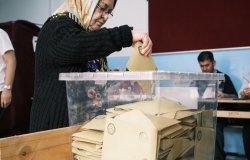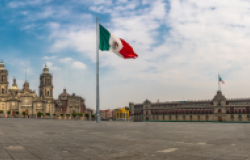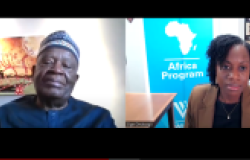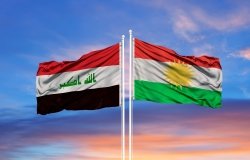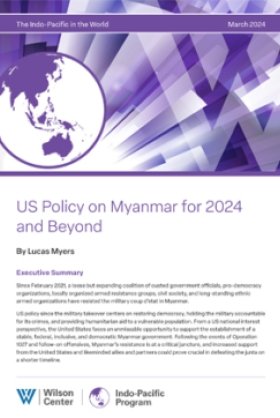On Multilateralism, Sovereignty and the Western Hemisphere: Concepts in Jeopardy
Former ambassador and Brazil Institute adivisory board member Luigi Einaudi reflects on the role of the OAS in an increasingly multilateral world.
Luigi R. Einaudi is a distinguished visiting fellow in the Center for Strategic Research, Institute for National Strategic Studies at the National Defense University, a member of the Wilson Center’s Brazil Institute Advisory Board, former Permanent Representative of the United States at the Organization of American States, and former Assistant Secretary General of the OAS.
Twenty three years ago this month, when I spoke to the Permanent Council for the first time as the Permanent Representative of the United States, the Ambassador of Brazil commented that only time would tell whether I had spoken as Ambassador Einaudi or as Professor Einaudi. I believe time showed I spoke then for the United States. Later, when I served as Assistant Secretary General and then Acting Secretary General, I did my best to represent all OAS member states. Today, I speak for myself and no one else.
The Organization of American States is a multilateral organization of the sovereign nation states of the Western Hemisphere. This apparently simple definition combines three concepts, all of them now unfortunately in jeopardy
First, Multilateralism
Multilateralism is more than the temporary agreement of two or more countries on a specific problem; it is cooperation based on “generalized principles of conduct.”
When generalized principles of conduct are given treaty form, they become international law. The United Nations Charter and the World Court are today the cornerstones of global order based on law. If age were the gold standard, the OAS and many of its constituent entities would be recognized among the precursors of multilateralism.
But today’s world is increasingly disorderly and fragmenting. Multilateral institutions are much criticized and associated more often with inefficiency than with order. International law has been weakened by repeated failures to ratify treaties or abide by their obligations.
Which leads to a question: is multilateralism being reduced to an idealistic illusion in an increasingly Hobbesian world?
Second, Sovereignty
The OAS Charter is based on the sovereign equality of states. Every state has one vote. Unlike the United Nations, democracy among nations at the OAS is not conditioned by a Security Council or members with vetoes. Respect for the principle of non-intervention means that individual states are essentially free to determine their participation in any particular activity.
In recent years, however, it has become increasingly clear that many of the problems of this globalizing age require cooperation. Illegal drugs, small arms transfers, migration and a host of other matters cross borders and cannot be addressed by any one state acting alone.
Which leads to a second question: Is the sovereign nation state becoming obsolete?
Third, the Western Hemisphere
The OAS Charter declares that “the historic mission of America is to offer to man a land of liberty.” In reality, of course, the Americas have never been united except in the western mythology of the New World. Its countries have shifting relationships, sometimes drifting apart, other times coalescing sub regionally.
It is nearly sixty years since the historian Arthur Whitaker declared that the Western Hemisphere Ideal, the “proposition that the peoples of this Hemisphere stand in a special relationship to one another which sets them apart from the rest of the world” was in irreversible decline.
So a third question arises: Do hemispheric relations still have a unique place in this globalizing world?
What does accumulated experience tell us?
First, Multilateralism
Practice reveals that multilateralism matters:
- Multilateralism is the basis of the common standards that make possible everything from world trade to operating safe flights across borders;
- Multilateral agreements are often more effective than bilateral ones. The 1977 Panama Canal Treaties were signed upstairs, in the Hall of the Americas, in the presence of the hemisphere’s heads of state and government, because all countries concerned, large and small, believed this increased the likelihood of compliance.
- Multilateral cooperation is also an instrument for institutional development and stability. Its legitimacy rests on embodying world opinion and impartiality – acting without favor toward any country or private interest.
I believe the OAS has two important comparative advantages:
- One, a fundamental contribution, is enabling the development of common legal standards and the harmonization of national laws. I would cite human rights, electoral observation, and civil identity among many others.
- Another contribution, perhaps less appreciated, is that OAS meetings, the General Secretariat, and seminars help forge a cadre of diplomats and public servants who learn how to turn a difficult world to mutual advantage. The graduates of Inter-American Course in International Law in Rio de Janeiro and the Inter-American Defense College at Fort McNair have enviable records of public service.
Second, Sovereignty
Nongovernmental actors, new technologies, global finance and more new issues, all challenge sovereignty. But the key is not to abandon sovereignty. It is to organize more effectively and develop personnel knowledgeable about the new issues and how to reconcile different national interests. Most foreign ministries have one chain of command for international organization affairs and a separate one for bilateral relationships. The capacity of foreign ministries to represent their entire government varies greatly from country to country and issue to issue.
Without more effective “whole of government” organization and knowledgeable personnel, sovereignty risks becoming an obstacle to needed cooperation more than a protection against foreign impositions.
Third, the Western Hemisphere
Two points suggest that the OAS is both more and less than a simple reflection of geography.
First, Western Hemisphere jurisprudence on human rights and democracy exceeds world practice.
- Unlike the United Nations Human Rights Commission, members of the Inter-American Commission on Human Rights serve in their own right rather than as representatives of governments.
- In 1991, Resolution 1080 made history in calling for an automatic convening of this Council if there was an interruption of the democratic process in a member state. The UN Charter does not contain the word “democracy.”
Second, the OAS is the only forum that brings the United States and Canada together with the rest of the hemisphere.
- The entrance of Canada and the independent Commonwealth Caribbean between 1967 and 1991 was a welcome step toward full regional participation.
- The United States and Canada together contribute more than two thirds of the regular quota funds of the OAS. These payments are essential to the functioning of the Secretariat and its programs.
Asymmetries like these differences in funding breed illusions and distrust. These obstacles can be reduced by respect for different views and fair administration of available resources. But symbolism also matters. Cuba’s sovereignty and OAS commitments to human rights and democracy will have to be satisfied before the government of Cuba returns to the OAS. But the continued absence of Cuba weakens the OAS’ claim to represent the entire hemisphere and gives credence to those who say the OAS is the U.S. Ministry of Colonies. Not entirely by coincidence, the new Community of Latin American and Caribbean States (CELAC) includes Cuba and excludes the United States and Canada.
Multidimensional Security
Defense and security matters are intimately related to geography. They also have a history even longer and more controversial than multilateralism and sovereignty. The League of Nations was created to end war but had no military capacity. To remedy this failing, Chapter VII of the United Nations Charter authorized the use of force by member states. The 1948 OAS Charter, however, quite purposely conveyed no coercive authority. This was partly due to the separate existence of the 1947 Inter-American Treaty of Reciprocal Assistance (the Rio Treaty) but partly also to a desire to avoid legitimizing any new U.S. military interventions.
The first forty years of the OAS were marked by tension between U.S. fears of Communist penetration and Latin American fears of U.S. intervention and unmet aspirations for economic cooperation. The 1954 covert intervention by the United States in Guatemala went unchallenged by most governments, which, however, increased pressure on the United States to provide aid that ultimately led to the founding of the Inter-American Development Bank. The Cuban revolution spawned the Alliance for Progress, which in turn facilitated the exclusion of the government of Cuba from the OAS in 1962 -- although the Alliance itself later foundered on differing perceptions and lack of resources. In 1965 the OAS supported -- after the fact -- the U.S. invasion of the Dominican Republic, but this became the last time the OAS would approve any form of military intervention. In 1979, the Ministers rejected an informal U.S. proposal for a peace force in Nicaragua. The OAS was largely marginalized from the subsequent Central American conflicts, and peace efforts there fell to ad hoc sub regional groups. In 1982 the U.S. failure to back Argentina against the United Kingdom in the Falklands/Malvinas war was interpreted regionally as a repudiation of Rio Treaty obligations. The OAS was sidelined when the U.S. invaded Grenada in 1983 and Panama in 1989, and yielded to Brazil, Argentina, Chile and the United States in the settlement of the Ecuador-Peru war of 1994-5.
Times have changed. Armed conflict among states in the Americas has become almost unthinkable. The end of the Cold War reduced fears of extra-hemispheric aggression. The peace between Peru and Ecuador resolved the last active territorial conflict on the South American mainland and removed the arms race contagion. Residual interstate differences, mostly in the Caribbean basin, are largely contained.
Building on this positive new environment, Mexico in 2003 took the initiative to convene a Special Conference on Security. Implicitly discarding the obligatory collective security paradigm of the Rio Treaty from which it had just withdrawn, Mexico broke with the Cold War past to support a concept championed by the CARICOM countries -- that security should be understood as “multidimensional,” not just military.
The Declaration adopted in Mexico City set forth a broad and flexible basis for voluntary cooperation. It affirmed a “new concept of security in the Hemisphere [that] is multidimensional in scope, includes traditional and new threats, concerns and other challenges.” This year’s AG/RES. 2735, entitled “Advancing Hemispheric Security: A Multidimensional Approach,” is a compendium of these challenges. Its 64 resolutory paragraphs concern traditional defense matters like conventional weapons acquisitions, CSBMs, and nuclear nonproliferation as well as newer challenges like trafficking in persons, drug abuse and the special security concerns of small island states.
Even with this new and consensual approach, security and defense matters have not avoided controversy and are still sometimes burdened by bad memories of the past. The variety and complexity of contemporary security issues makes clear that no one policy fits all. And each member state has set its own course. Citizen security, to take a pressing example, requires local leadership and cannot be imposed from the outside. Nor can it be imposed by force. Military forces are trained to defend national sovereignty against external attack by a foreign enemy. They are not trained to engage their fellow citizens. Even if police forces are ineffective, asking military units to fight drugs or domestic crime automatically raises political concerns, even when military involvement is meant to be temporary and efforts are made to avoid militarization of law enforcement.
The Mexico City Declaration recognized of course that “each state has the sovereign right” to determine its own strategy and affirmed that “bilateral and subregional agreements in the area of security and defense are essential to strengthening security in the Hemisphere.” Sub regional organizations – CARICOM, SICA and UNASUR – have become increasingly important and deserve recognition and support.
Against this general background, I see four imperatives where the OAS has comparative advantages:
First, support common legal standards, international law and respect for sovereignty. There are “red lines” that should not be crossed by foreigners – even if they think they have the permission of local authorities. This is particularly important for the United States, the hemisphere’s most activist power, which has for some years stood aloof from the commitments of international law. In 2009, every US Assistant Secretary of State for Western Hemisphere Affairs since 1976, all US Ambassadors to the OAS since 1989, all US Chairmen of the Inter-American Defense Board since 1989, and two thirds of the Commanders of US Southern Command since 1983, joined me in asking the US Senate to ratify CIFTA, the Inter-American Convention against the Illicit Manufacturing of and Trafficking in Firearms, Ammunition, Explosives, and Other Related Materials. It is not as though we do not understand what needs to be done.
Second, facilitate a “whole of government” approach. Military leaders and institutions cannot be excluded from any “whole of government” strategy. What matters, in the language of the 2003 Declaration, is to ensure the “subordination of all state institutions to the legally constituted civilian authority.” The Inter-American Defense Board (IADB), founded in 1942 to organize against the Axis, was held in diplomatic limbo during the Cold War and recognized as an OAS entity in 2006 and assigned advisory functions. What needs changing now is less the formal statute than the culture of relations between foreign and defense ministries so as to support needed civil-military cooperation.
Third, forge cadres of competent cooperators. Graduates of the Course in International Law and of the Inter-American Defense College strengthen the capacity of their respective states as well as their own professionalism. The College now enrolls both civilians and police officers; I believe it should be encouraged to become an Inter-American center for Public Administration. The European observer states have different experiences and security forces, including constabularies. Their expertise should also be drawn upon.
Fourth, provide multilateral support for local institutions willing to accept it. In Guatemala, the International Commission against Impunity (CICIG) operates under Guatemalan law, in the Guatemalan courts, and follows Guatemalan criminal procedure. It works closely with selected staff from the Public Prosecutor's Office and the National Civil Police and provides technical assistance to local judicial institutions. CICIG depends on the UN, but mainly because the UN has the funds; if requested and funded, the OAS could respectfully and effectively extend this support through SICA to other countries of Central America.
By way of conclusion
The credibility of the OAS has been damaged by a tendency, particularly notable at Summit meetings, to assign the OAS grandiose tasks but no resources to even begin to tackle them. We cannot of course just blame the Heads. In 1991, before the current series of Summits had begun, Resolution 1080 called for “incentives to preserve and strengthen democratic systems, based on international solidarity and cooperation.” A generation and much rhetoric later, there is little solidarity beyond the threat of ostracism after breakdowns have already taken place.
So I conclude by returning to my opening. The OAS provides a highly workable and democratic framework for multilateral cooperation among the sovereign states of this hemisphere. Whether and how they make it work depends squarely on them.
This article is adapted from a speech on “The OAS and Multidimensional Security,” delivered at a Special Session of the Organization of American States convened on November 8, 2012 to reflect on the OAS.
About the Author


Brazil Institute
The Brazil Institute—the only country-specific policy institution focused on Brazil in Washington—works to foster understanding of Brazil’s complex reality and to support more consequential relations between Brazilian and US institutions in all sectors. The Brazil Institute plays this role by producing independent research and programs that bridge the gap between scholarship and policy, and by serving as a crossroads for leading policymakers, scholars and private sector representatives who are committed to addressing Brazil’s challenges and opportunities. Read more

Brazil Institute
The Brazil Institute—the only country-specific policy institution focused on Brazil in Washington—works to foster understanding of Brazil’s complex reality and to support more consequential relations between Brazilian and US institutions in all sectors. The Brazil Institute plays this role by producing independent research and programs that bridge the gap between scholarship and policy, and by serving as a crossroads for leading policymakers, scholars and private sector representatives who are committed to addressing Brazil’s challenges and opportunities. Read more
